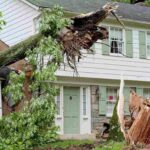Ever walked outside after a storm passed through and wondered if your roof took a beating? I get it.
Your roof silently protects everything you own, yet most folks don’t think about it until something goes wrong.
But here’s the thing: catching roof damage early can save you thousands of dollars and prevent those dreaded indoor water features nobody asked for.
Storms in Minnesota don’t mess around.
Between our wild winds, hailstorms that seem to come out of nowhere, and heavy snow loads, Faribault homes see their fair share of roofing wear and tear.
The trick is knowing what to look for before small problems turn into big headaches.
Let’s walk through the telltale signs your roof needs professional attention.
These aren’t just minor issues you can put off until next season—these are the red flags that should have you reaching for your phone.
Signs Of Storm Damage That Requires A Call To Roofers In Faribault
When storms roll through Faribault, they can leave your roof in rough shape even if you don’t notice problems right away.
Most roof damage doesn’t announce itself with dramatic leaks right off the bat. Instead, it often starts small and gets worse over time.
What makes storm damage tricky? It’s not always obvious from ground level.
Some issues hide until they’ve already caused structural damage or mold growth inside your attic.
That’s why knowing what to look for after severe weather can make all the difference.
The good news? You don’t need to climb up there yourself.
A quick visual check from the ground plus an indoor inspection can reveal many warning signs.
For anything suspicious, professional roofers have the training, equipment, and experience to safely assess the situation.
Now let’s get into the specific signs you should never ignore.
Missing or Damaged Shingles
Those asphalt shingles aren’t just there to make your house look pretty—they’re your roof’s first line of defense.
When strong winds rip through town, they can lift, crack, or completely tear off shingles.
Take a walk around your property after a storm.
Look for shingles lying in your yard or driveway—that’s the most obvious clue. But also scan your roof from the ground using binoculars if you have them. Watch for:
- Bare spots where shingles used to be
- Shingles that look crooked or misaligned
- Curled or lifted edges
- Cracks across the surface
Even one missing shingle creates a vulnerable spot where water can seep underneath and cause rot in the wood beneath.
That small problem quickly becomes a big one during the next rainfall.
In Faribault roofers can easily replace or repair the shingles to prevent further damage from occurring, but only if you catch the problem early.
Don’t assume minor shingle damage isn’t serious.
Those protective granules on top of shingles shield them from UV rays.
Once damaged, shingles age much faster, meaning you’re on borrowed time before leaks develop.
Roof Leaks and Water Stains
Water stains on your ceiling or walls might as well be neon signs flashing “roof problem!” These yellowish-brown spots often appear after storms and indicate water has found its way inside.
Check your attic first after heavy rain. Bring a flashlight and look for:
- Wet insulation
- Damp wood
- Water droplets on nails coming through the roof deck
- Mold or mildew smell
Don’t stop at obvious water spots.
Sometimes leaks travel along rafters before dripping down, meaning the stain might not be directly under the actual roof damage.
The tricky part after leaks? By the time you notice water inside, it’s usually been getting in for a while.
That means potential mold growth, rotted wood, or damaged insulation could already be issues.
Water damage never fixes itself.
It only gets worse—and more expensive to repair.
A small leak can eventually lead to ceiling damage, ruined insulation, and even electrical hazards if water reaches your wiring.
If you spot leaks after a storm, you’ve got active water intrusion that needs immediate attention from qualified Faribault roofing professionals.
Damaged Flashing and Roof Fixtures
Flashing might not be the star of your roof show, but it plays a crucial supporting role.
These thin metal pieces seal the joints around chimneys, vents, skylights, and where roof planes meet.
When storms hit, they can bend, crack, or completely dislodge your flashing.
Roof fixtures like vents and pipe boots are also vulnerable to storm damage.
Strong winds can crack plastic components or loosen their seals.
Hail can punch holes through these materials even if your shingles survive.
After a storm, check if:
- Metal flashing appears bent, loose, or missing
- Caulking around fixtures looks cracked or separated
- Vent covers are cracked or damaged
- Chimney caps are still intact
The danger with damaged flashing and fixtures is that they create direct water entry points.
Unlike a missing shingle where water might eventually find its way in, damaged flashing often causes immediate leaks because these areas already represent natural vulnerabilities in your roof system.
While you might be tempted to smear some caulk on the problem, proper flashing repair requires professional techniques to create lasting waterproof seals.
DIY fixes often fail quickly and can actually trap moisture, making problems worse.
Hail Impact Marks
Hail is like nature’s golf balls falling from the sky—except there’s nothing fun about the damage they cause.
Even small hail can create issues that worsen over time.
Fresh hail damage looks different depending on your roofing material. On asphalt shingles, look for:
- Dark spots where granules have been knocked off
- Small dimples or depressions
- Soft spots that feel spongy if you press them (check only if it’s safe to do so)
- Circular cracks in the shingle surface
The sneaky thing about hail damage? It might not cause immediate leaks.
Instead, it shortens your roof’s lifespan by removing those protective granules and creating weak spots that deteriorate faster.
Insurance companies often cover hail damage, but most policies have time limits for filing claims.
That’s why professional assessment after hailstorms is so important—the damage might not become obvious until months later when your insurance window has closed.
Many homeowners miss hail damage because it can be subtle.
When in doubt, get a free inspection from a qualified Faribault roofing contractor who knows exactly what to look for and can document damage properly for insurance purposes.
Granule Loss and Clogged Gutters
After a rough storm, check your gutters and downspouts.
Finding piles of tiny black, blue, or green granules means your shingles are shedding their protective coating.
Some granule loss is normal as roofs age, but storms accelerate the process. Wind and hail literally scrub these protective particles off your shingles.
When you lose too many granules, your shingles become vulnerable to sun damage and crack more easily.
Storm-related granule loss shows up as:
- Gutters filled with granules after rain
- Bare spots on shingles that look lighter than surrounding areas
- Uneven coloration across your roof
- Excessive granules at the end of downspouts
While checking for granules, look for other debris clogging your gutters.
Clogged gutters after storms prevent proper drainage, forcing water back up under shingles or causing gutters to pull away from your house under the weight.
Clean gutters direct water away from your home.
Clogged ones turn that same water into a weapon against your roof and foundation.
After major storms, clearing debris helps prevent cascading damage to multiple parts of your home.
Sagging Roof or Structural Damage
A sagging roofline is the most serious sign of storm damage and requires immediate professional attention.
This indicates the structural supports of your roof have been compromised.
From the ground, back up and look at your roofline. It should appear straight along ridges and rafters. Watch for:
- Any dips or waves in what should be a straight line
- Obvious sagging areas, especially in the center of the roof
- Interior ceiling cracks that have appeared after storms
- Doors that suddenly stick or windows that won’t close properly
Structural damage isn’t always from one catastrophic storm.
Sometimes it results from repeated weather events that gradually weaken roof supports.
Heavy snow followed by rain can be particularly problematic as the weight increases dramatically.
Inside your attic, check for:
- Cracked or broken rafters
- Splitting wood at connection points
- Daylight visible through the roof deck
- Wet or compressed insulation
Never delay on structural issues.
They don’t improve with time and can lead to catastrophic roof failure.
While repairs for structural damage cost more upfront, they prevent the much higher expense of a collapsed roof and everything it damages on the way down.
Conclusion
Your roof takes the brunt of Minnesota’s wild weather, and spotting storm damage early can save you significant headaches and money.
The six signs we’ve covered—missing shingles, water stains, damaged flashing, hail impacts, granule loss, and structural concerns—all warrant professional attention.
Don’t wait until water pours through your ceiling to take action.
Many roofing companies in Faribault offer free storm damage inspections, giving you peace of mind without upfront cost.
Remember that most homeowners insurance policies cover storm damage, but they expect you to take reasonable steps to prevent further issues.
That means prompt inspection and repair after severe weather.
Your roof protects everything beneath it—your family, belongings, and home investment.
Treating storm damage as urgent business isn’t overreacting; it’s smart homeownership that pays off through a longer-lasting roof and fewer indoor surprises when the next storm rolls through.



